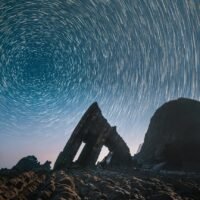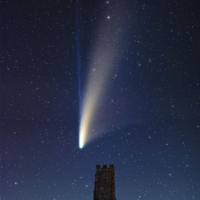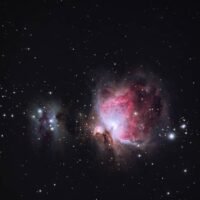The Orion Nebula (Messier 42) is a spectacular star-forming region located approximately 1,344 light-years from Earth, in the constellation of Orion. It spans an immense 24 light-years across and is one of the brightest and most studied nebulae in the night sky.
Observing from City Centre:
Given the urban light pollution typical of a city , capturing the Orion Nebula would require either a high-quality telescope with a narrowband filter or a long-exposure camera setup. Even then, the nebula’s vibrant features might be muted compared to darker sky locations.
Key Features:
- Central Brightness: The nebula glows prominently due to the intense ultraviolet radiation emitted by the young, hot stars in the Trapezium Cluster at its core.
- Colors: A mixture of pinks, reds, and purples dominate in images, caused by ionized hydrogen gas (Hα emission) and reflected starlight from surrounding dust.
- Details:
- Stellar Nurseries: Within its glowing cloud are dense regions of gas and dust where stars and planetary systems are forming.
- Structure: Its wispy filaments and folds are shaped by complex interactions between gravity, stellar winds, and magnetic fields.
Unique Challenges in an Urban Setting:
- Light Pollution: The nebula’s fainter outer regions and subtle colors may be lost to the skyglow, but the central bright area should still be visible.
- Atmospheric Conditions: Urban heat and particulates can distort the image, emphasizing the importance of clear and stable skies.
Despite these challenges, the Orion Nebula remains one of the most rewarding celestial objects to observe, even in urban areas, as its central luminosity can pierce through city skies with the aid of proper equipment.















